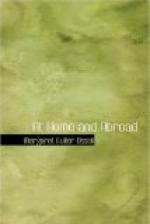In the autumn of 1844, she accepted an invitation to take part in the conduct of the Tribune, with especial reference to the department of Reviews and Criticism on current Literature, Art, Music, &c.; a position which she filled for nearly two years,—how eminently, our readers well know. Her reviews of Longfellow’s Poems, Wesley’s Memoirs, Poe’s Poems, Bailey’s “Festus,” Douglas’s Life, &c. must yet be remembered by many. She had previously found “fit audience, though few,” for a series of remarkable papers on “The Great Musicians,” “Lord Herbert of Cherbury,” “Woman,” &c., &c., in “The Dial,” a quarterly of remarkable breadth and vigor, of which she was at first co-editor with Ralph Waldo Emerson, but which was afterward edited by him only, though she continued a contributor to its pages. In 1843, she accompanied some friends on a tour via Niagara, Detroit, and Mackinac to Chicago, and across the prairies of Illinois, and her resulting volume, entitled “Summer on the Lakes,” is one of the best works in this department ever issued from the American press. It was too good to be widely and instantly popular. Her “Woman in the Nineteenth Century”—an extension of her essay in the Dial—was published by us early in 1845, and a moderate edition sold. The next year, a selection from her “Papers on Literature and Art” was issued by Wiley and Putnam, in two fair volumes of their “Library of American Books.” We believe the original edition was nearly or quite exhausted, but a second has not been called for, while books nowise comparable to it for strength or worth have run through half a dozen editions.[A] These “Papers” embody some of her best contributions to the Dial, the Tribune, and perhaps one or two which had not appeared in either.
[Footnote A: A second edition has since been published.—ED.]
In the summer of 1845, Miss Fuller accompanied the family of a devoted friend to Europe, visiting England, Scotland, France, and passing through Italy to Rome, where they spent the ensuing winter. She accompanied her friends next spring to the North of Italy, and there stopped, spending most of the summer at Florence, and returning at the approach of winter to Rome, where she was soon after married to Giovanni, Marquis Ossoli, who had made her acquaintance during her first winter in the Eternal City. They have since resided in the Roman States until the last summer, after the surrender of Rome to the French army of assassins of liberty, when they deemed it expedient to migrate to Florence, both having taken an active part in the Republican movement which resulted so disastrously,—nay, of which the ultimate result is yet to be witnessed. Thence in June they departed and set sail at Leghorn for this port, in the Philadelphia brig Elizabeth, which was doomed to encounter a succession of disasters. They had not been many days at sea when the captain was prostrated by a disease which ultimately exhibited itself as confluent small-pox of the most malignant




